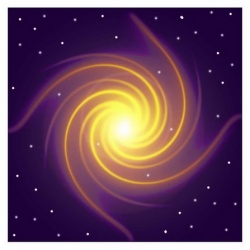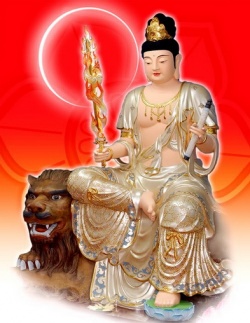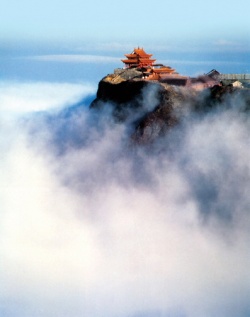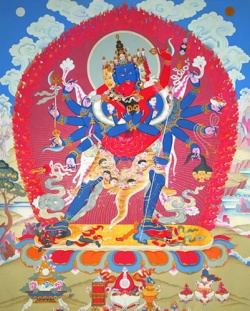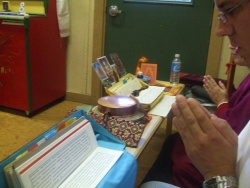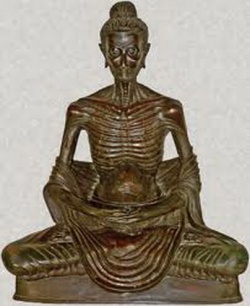The attaining of Buddhahood
Taught by Lopon Tenzin
The Mahayana recognizes the Trikaya - The Three Bodies of the Buddha, but the Hinayana does not do so. The followers of the Hinayana only recognize the existence of a historical Buddha who lived in the past. That Buddha Shakyamuni was Ue, an Arhat - one who had purified all of his Kleshas (passions or negative emotions) and vasanas (karmic traces). After his Enlightenment the residual Karma that remained with him was represented by his physical Body. This impure Body persisted for a time but his Mind was entirely purified of obscurations. Then, after passing into Parinirvana, absolutely nothing remained behindm, neither Body nor Mind. So when we pray to The Buddha this action is no more than a commemoration because there is no one there to hear us. We receive no Blessings and no Wisdom from him because The Buddha is no more. There is only the memory of his teachings and example found recorded in the scriptures. Nonetheless he showed the path to Liberation from the sufferings experienced in Samsara and we can follow and practice that same path. But the goal according to the Hinayana is to liberate oneself alone from Samsara, that is to become an Arhat - one who has eliminated all the Kleshas and karmic traces afflicting the Mind stream. This is the view of the Hinayana However, by practicing this path of the Hinayana we realize only the status of an Arhat but not the full Enlightenment of a Buddha.
2 The Mahayana view
According to the traditional cosmology found both in Bon and in Buddhism there are three principal levels of existence in the Universe:
(1) The Kamadhatu or Desire World where all Sentient beings including the gods or Devas are dominated by their sense desires (Kama);
(2) the Rupadhatu or Form World where the gods dwell who have exceedingly subtle bodies (rupa) and sense organs of Light and who are no longer dominated by gross sense desires (Kama); and
(3) the Arupadhatu or Formless World where beings have no Form (Arupa) and exist in a dimension of cosmic Consciousness.
The highest plane of existence found at the summit of the Rupadhatu is known as Akanishta or Ogmin (og min) in Tibetan and at level of existence there reside the Akanistha Devas (og min lha). As we ascend upward through the celestial planes of the Rupadhatu we find that the bodies of Light of the Devas residing on each plane progressively become more subtle, clear, and pure. So when we are ready to attain Buddhahood after an existence as a human being on earth we find ourselves reborn in the Akanistha Heaven because there on that plane the manifest Form which embodies the enlightenment experience of a Buddha is the one most suitable. That is to say we acquire a subtle and highly refined Body of Light by Virtue of our Rebirth in the Akanistha realm. Here in this Akanistha Heaven we continue to practice in order to purify our stream of Consciousness of all obscurations even the most subtle and Unconscious of obscurations. Once purified of all shadows we attain Buddhahood in Akanistha as the Sambhogakaya. That is to say we now have realized the Sambhogakaya Form. This is how one attains Buddhahood according to the Sutra system of the Mahayana. According to Bon one must first be reborn in Akanistha as an Akanistha Deva in order to possess a suitable Body or Form for Enlightenment. Here the individual attains the Sambhogakaya and then descends into the lower worlds in order to manifest as the Nirmankaya on the physical earth plane. The Mind of The Buddha is the Dharmakaya which possesses the twofold purity that is an intrinsic purity as well as a freedom from all adventitious taints. This Dharmakaya is inconceivable and inexpressible; it is without limits. But the manifestation of The Buddha's Energy (thugs rje) is the Sambhogakaya in a purified Form of Light and energy. It is something visible. This is the Speech aspect of The Buddha. The great Bodhisattvas, when they have attained the higher Bhumis or stages can perceive this glorified Body. But there are also the countless Suffering beings of the Kamadhatu who with their obscurations cannot perceive the Sambhogakaya, and for their sakes The Buddha manifests innumerable projections or emanations (nirmitas) of his forms into all inhabited worlds and these are known as Nirmanakayas or Emanation Bodies (sprul sku). These bodies can be perceived by beings whose minds are obscured by the Kleshas (passions) and by sense desires. The Sambhogakaya is like the sun in the sky and its Light shines everywhere. There is only a single sun in the sky but there are many reflected images of this single sun in the many vessels of water on the ground. These reflected images are the Nirmanakayas. But only when the practitioner has attained the path of vision (the Darshana narga, the third among the Five Paths) have we sufficiently purified our obscurations so that we can see the Sambhogakaya and hear its teachings directly. Ignorant Sentient beings are only capable or perceiving the Nirinanakaya.
3 The Tantra View
But in the Tantra system we find a different method described where it is not necessary to first be reborn in the Akanistha Heaven in order to obtain a subtle Body of Light. This method is known as Mayadeha the Illusion Body or in Tibetan Gyulu (sgyu lus). In this case during our lifetime here on earth we do the practice of Dzogrim (rdzogs rim) which is the second phase of Tantric transformation, and we create in our Heart center a very refined Illusion Body by way of a union of subtle prana and Mind. This Gyulu or Illusion Body provides a suitable base for the manifestation of the Sambhogakaya and so it is not necessary to seek this base in any other dimension of existence. We have created this Gyulu during our lifetime on earth through our practice and then at the time of our Death we transfer our Namshe or Consciousness into it and it then becomes the vehicle for our Sambhogakaya.
There are however two kinds of Cyulu pure and impure. If at the time of our Death we have not attained perfect realization and purified all our subtle obscurations both emotional and Intellectual then this subtle Body born of the unification of prana and Mind is known as an impure Illusion Body. In that case we must do further Purification practice in that Body in order to realize perfect Enlightenment. Only when we attain that state can we speak of a pure Illusion Body. The manifesting of this Gyulu has wrongly been called a Rainbow body (ja lus) or a Body of Light (od lus). It is neither because the manifestation of this Sambhogakaya Form depends on our prior practice and realization of both Kyerim (bskyed rim), the process of generation and Dzogrim (rdzogs rim), the process of perfection. Where the view and the practice are different then the fruit or result will be different. So these manifestations the Illusion Body and the Rainbow body are not at all the same.
4 The Dzogchen view
Akanistha Heaven (the Sutra method) do not represent real Buddhahood. Nor is an Arhat (the state realized through the Hinayana method) represent a real Buddha. Once the Arhat has attained this state of having cut off all his Kleshas at their roots he need no longer be reborn as a human being but at a more exalted level of existence he must continue the process of purifying his stream of Consciousness because he is still afflicted with various Intellectual obscurations. Finding himself now at a higher level existence after his last human Rebirth, the Arhat must enter into the practice of the Mahayana path in order to realize Buddhahood. Similarly the Tantric practitioner who has realized the Gyulu does not need to take another human Rebirth. But since this Gyulu is something that arises from causes and the same is true of Rebirth in Akanistha it is therefore not permanent. If Knowledge of the Dharmakaya were brought about by antecedent causes it would be something that is impermanent. We cannot proceed from our conditioned existence to an unconditioned state. There is no way.
There are two aspects to the Dharmakaya: that which is impermanent and unconditioned and that which is permanent and unconditioned [For example just as there is the infinity of space and at the same time there is the space inside of an earthen jar; the one is permanent and the other is temporarily confined by the clay walls of the jar When the jar is broken they are one space]. If Buddhahood is brought about by antecedent causes it is not an unconditioned state. It is not permanent. It will come to an end just as any Mystical experience brought about by Meditation comes to an end and thereafter we resume an ordinary deluded level of Consciousness. The fundamental principle here is that all conditioned things are impermanent and this Truth has been taught by all the Buddhas. However, according to the Sutra system the accumulation of Wisdom is the cause of the Dharniakaya and the Accumulation of merit is the cause of the Rupakaya. Is there a logical contradiction here?
After attaining Enlightenment a Buddha reappears in the World to teach the Dharnia to humanity because of his Bodhichitta and his Pranidhana vow made previously - that vow is the cause for the manifesting of the Rupakaya according to the Sutra interpretation. But this Rupakaya appears to us because of our needs, not because The Buddha has any desire or aspiration. He teaches us through the vehicle of Speech - that is to say the Sambhogakaya the manifestation of his energy but his Mind is the Dharmakaya. But the Dharmakaya is unconditioned; it is in no way afflicted or limited by thoughts and desires It is like the clear open unobstructed sky whereas the Sambhogakaya is like the sun in the sky. It sheds its Light everywhere impartially and indiscriminately; and these rays of the sun are like the Nirmanakaya. But if we are sitting in a cave on the north side of the mountain we must come out of that cave in order to see the face of the sun even though its Light shines everywhere. It is the same with the Sambhogakaya. In its essence the Dharmakaya is empty and formless like the sky; it is unconditioned and permanent. But on the side of Wisdom (shes rab) it is impermanent because this Wisdom arises from causes. So how can the real Dharmakaya arise from an accumulation of Wisdom as the cause?
But matters stand quite differently according to Dzogchen. In the Dzogchen Upadesha teachings we have the practices of Thegchod and Thodgal. Thegchod means we enter into and continue in the state of contemplation (Rig pa), the Natural State (gnas lugs). Thodgal means that while in the state of contemplation the potentiality of the Natural State (Rig pa 1 rtsal) has the occasion to manifest spontaneously as vision. The medium for the manifesting of this potentiality is either sunlight total darkness or the open space of the sky. The ultimate result of this Thodgal practice is the attaining of the Rainbow body or Talu (ja lus). This means that we have attained the Sambhogakaya already because it is contained in potential in the Natural State. It is not something that is brought about historically by antecedent causes. Rather it has been primordially present because it represents the inherent potentiality or energy of the Natural State (Rig pa i rtsal) itself. This method is only found in Dzogchen and not in the other vehicles. Here the Sambhogakaya is not caused by something else other than itself such as a vow or Dzogrim practice. It is a spontaneously self-perfected manifestation (Ihun grub). But in terms of our experience it is a visible thing and like all visible things it is changeable and impermanent. Therefore a Rupakaya is always impermanent. It does not just sit on a throne in the sky throughout eternity unchanged century after century.
Indeed Thodgal does possess a method for dissolving the impure physical Body at the time of Death or even before and then the Rainbow body of Light manifests. But this is not a process of transforming an impure physical Body into a pure Sambhogakaya. The method Proper to Dzogchen is not the path of transformation as is the case with the Tantras but the path of self Liberation. So the procedure in Tantra and in Thodgal is quite different. To effect a transformation in vision and in energy Tantra employs visualization in terms of Kyerim and Dzogrim practice. We visualize ourselves in a Sambhogakaya Form whether this be a peaceful or a wrathful manifestation. But in Dzogchen there is nothing to be visualized and nothing to be transformed. The visions which arise during the course of Thodgal are not visualizations. Visualization represents the work of the Mind; visualizations are created by the Mind. But Dzogchen is a state beyond the Mind. So these visions which arise in Thodgal are not created by the Mind or by Unconscious Karma but they are a manifestation of what is already primordially present in the Natural State. The vision is not something created by causes but it is Lhundrub (Ihun grub) or spontaneously perfected. Since the Sambhogakaya is already fully inherent in the Natural State it simply manifests. Dzogchen alone discloses our real nature; Dzogchen has already discovered this inherent Buddhahood our real nature and so it can manifest the Sambhogakaya effortlessly. At the culmination of the Thodgal process at the stage of vision called the exhausting of everything into Reality (bon nyid zad pa) all of the visions that the practitioner experiences whether pure or impure dissolve into the Natural State. This includes our physical Body which is the result of past karmic causes and represents our impure karmic vision. For the practitioner everything dissolves. This sets the stage for the spontaneous manifestation of the Sambhogakaya which has been present in potential in the Natural State from the very beginning. Since it is already there no primary cause for its manifestation is needed. [The secondary causes for its manifestation however are the purifications of obscurations along the path. This is like the winds removing the clouds from the sky so that the face of the sun becomes visible or like opening the doors to the temple so that the image of the Buddha can clearly be seen].
If we examine the notion of Buddhahood from the logical standpoint we find that the Nirmanakaya and the Sambhogakaya are impermanent whereas the Dharmakaya alone is permanent. But when we further examine the Dhan-nakaya we discover that there are two sides to it. On the side of Emptiness it is permanent but on the side of Wisdom it is impermanent. The Kunzhi the basis of everything is permanent because it is Emptiness but Rigpa is impermanent because it is not always manifest. These two Kunzhi and Rigpa are always inseparable (dbyer med) in the Natural State. On the side of Emptiness (stong cha) there is permanence but on the side of clarity (gsal-cha) or awareness (rig-cha) there is Impermanence. So the manifestation side is impermanent; it is changing all of the time whereas the Emptiness side is Constant and permanent. We can logically distinguish these things when we speak about the Natural State but the Natural State is a totality and a perfect unity. Within it Emptiness and clarity are inseparable and never otherwise. This inseparability or Yermed (dbyer med) is the essence of Dzogchen. To fall either on the side of Emptiness or on the side of manifestation is to deviate from Dzogchen.
To realize the Rainbow body means that we have practiced Thodgal and not some other method. The visions that arise are not specifically created but appear spontaneously (Ihun grub) in the presence of secondary causes such as sunlight, total darkness, and the clear open sky. They arise spontaneously from the Natural State; no Kyerim or Dzogrim practices must be done first as preparation. All that is required is the capacity to remain with stability in the Natural State. This is called stable Thegchod. Then the Thodgal visions come automatically whether in sunlight or total darkness or in the empty sky. Gradually all the pure visions of the deities arise and these visions develop by way of four stages (snang ba bzhi) until completion. Then they all dissolve into the Natural State. Our personal reality of pure and impure vision (snang ba) dissolves into Reality (bon nyid) which is the Natural State. At the same time that our visions dissolve our physical Body also dissolves because it is just one manifestation of our impure karmic vision. Our normal everyday impure vision has the same source as the Thodgal pure vision - and now both equally dissolve into their source the Natural State. There is a single Base, the Natural State, but there are two Paths - impure karmic vision and pure vision, and two Fruits or results - Samsara and Nirvana. Returning to the ultimate source then the potentiality of the Natural State manifests as a Rainbow body, the real Rupakaya.
This lalu or Rainbow body can appear in a material sense to Sentient beings in order to teach them. The Rainbow body is not material but appears to be so since it can act on all of the senses of a sentient being simultaneously. The Sambhogakaya can be perceived only by the Aryas the Boddhisattvas who have ascended the third, fourth, or fifth paths [that is the Paths of Vision of Meditation Development and Culmination]. They can hear the teachings of the Sambhogakaya whereas ordinary beings cannot see nor hear this manifestation. So it is the Nirmanakaya that they hear and perceive. To human beings this Nirmanakaya appears as human. In other worlds and with other species of beings the situation will be different. But the Rainbow body as the potentiality of the Natural State is not limited to any particular Form. It can appear in a myriad of different forms. The Natural State has been with us from the very beginning. We have done nothing more than to rediscover it continue in it and allow its potentiality to manifest. That is Buddhahood.
